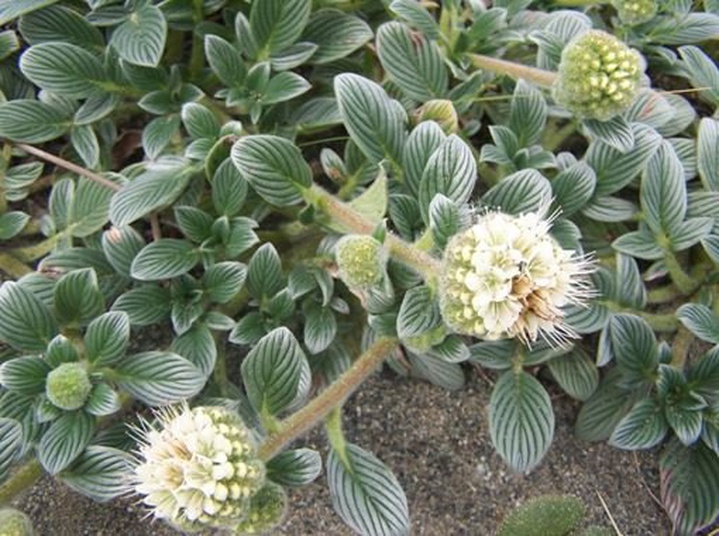Jessica Cejnar Andrews / Monday, March 21, 2022 @ 4:02 p.m.
Federal Wildlife Officials Propose Protection for Silvery Phacelia, a Rare Plant Whose Largest Stronghold is in Del Norte

The sand dune phacelia, or silvery phacelia, is found between Crescent City and Bandon. | Photo by Sandra Jerabek of the Tolowa Dunes Stewards
A flowering perennial in the forget-me-not family whose largest remaining stronghold is in Del Norte County’s coastal dunes is being considered for protection under the Endangered Species Act.
The sand dune phacelia, or silvery phacelia, is found in 25 naturally occurring populations between Crescent City and Bandon, according to a U.S. Fish and Wildlife Service news release Monday.
With its most significant threat coming from invasive species, primarily European beach grass and gorse, federal wildlife officials propose listing the silvery phacelia as threatened under the Endangered Species Act and is seeking public comment.
Federal wildlife officials propose designating about 13 units, or 252 total acres, as occupied critical habitat across the silvery phacelia’s range. The U.S. Fish and Wildlife Service also proposes making the removal, digging up, damaging or destroying of silvery phacelia on non-federal lands illegal, according to the news release.
“Nearly 70 percent of the remaining sand dune phacelia populations are in poor condition, and most known locations are on non-federal lands,” Robyn Thorson, regional director for the Fish and Wildlife Service’s Pacific Northwest Region, said in a written statement. “Although this coastal plant is in dire need of help, we are optimistic that we will see its recovery by working closely with our partners in conservation.”
For Sandra Jerabek, director of the Tolowa Dunes Stewards — one of those “partners in conservation” — the US Fish and Wildlife Service’s announcement is welcome news.
Jerabek has led volunteer efforts to eradicate European beach grass from the Lake Earl Wildlife Area and Tolowa Dunes State Parks just north of Crescent City for about 18 years. Not only does the silvery phacelia deserve federal protection, she said she’s hoping that listing it as threatened will mean the Tolowa Dunes Stewards’ efforts get more support and funding.
“It doesn’t grow anywhere else in California,” she said of the phacelia. “Because of our removal of European beach grass and only because of our removal of European beach grass is our restoration area a stronghold for this plant, and I think this is great.”
The proposed listing of the silvery phacelia as threatened comes after the Center for Biological Diversity EPIC) filed a lawsuit in 2020. That lawsuit sought to force the U.S. Fish and Wildlife Service to make timely evaluations and protection decision for 241 plant and animal species, including the silvery phacelia.
The Center for Biological Diversity filed its lawsuit after it and seven other conservation groups, including Friends of Del Norte, the California Native Plant Society and the Environmental Protection Information Center submitted a petition in 2014 to protect the species, according to a Center for Biological Diversity news release Monday.
European beach grass is a monoculture that covers much of the ground and crowds out native plants, Jerabek said. At Tolowa Dunes State Park, the foredune, which runs parallel to the ocean, is “armored” with it.
The European beach grass has built the foredune up into what she describes as a steep vertical wall above the beach. It prevents fresh sand from migrating inland and forming a new beach and new sand dunes, Jerabek said.
Silvery phacelia, and most of the native plants in the dunes, are adapted to moving sand, Jerabek said.
But for the past six years, Jerabek and a core team of about 20 volunteers pulled European beach grass up by hand and monitored the area to keep it from sprouting again. There were only eight silvery phacelia plants in the area when they began their project, she said. Now, there are more than 400.
“It starts to come up immediately after you remove the beach grass,” Jerabek said. “If you remove European beach grass, silvery phacelia returns.”
Gorse is a problem for the silvery phacelia in Curry County, Jerabek said, but it hasn’t been found in the Tolowa Dunes Stewards’ restoration areas in Del Norte.
Recently the Tolowa Dunes Stewards has partnered with the Tolowa Dee-ni’ Nation and received permits to use heavy equipment to remove European beach grass on about four acres in the Lake Earl Wildlife Area.
But because the area is environmentally sensitive with wetlands, a salt marsh and six different species of rare plants, including silvery phacelia, heavy equipment is only permissible on the foredune, Jerabek said.
Tolowa Dunes Stewards volunteers venture out onto the dunes — primarily the Big Dune in Tolowa Dunes State Park — about twice a month to pull European beach grass. Now that another invasive, Scotch broom, is in season, volunteers go out every weekend to pull it if the weather allows, Jerabek said.
Tolowa Dunes Stewards have also done work in Jedediah Smith Redwoods State Park to pull English ivy and plan to do more work with youth volunteers over the summer.
For more information about the Tolowa Dunes Stewards, visit its Facebook page or send a text message to (707) 954-5253.
The 60-day public comment period on the proposed listing of the silvery phacelia as threatened under the Endangered Species Act is open through May 23. The US Fish and Wildlife Service is seeking information about the plant’s biology, distribution, status and population trends as well as information about its proposed critical habitat designation.
To submit comments, click here and search under docket number FWS-R1-–ES–2021–0070.
CLICK TO MANAGE